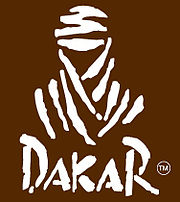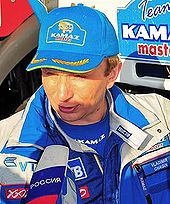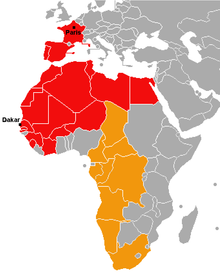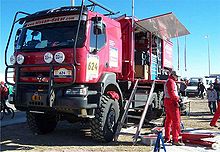- Dakar Rally
-
Dakar Rally 
Category Rally raid Country or region Europe and Africa (1979–2007)
South America (2009–present)Inaugural season 1979 Drivers 362 Drivers' champion  Marc Coma (Bikes)
Marc Coma (Bikes)
 Alejandro Patronelli (ATV/Quads)
Alejandro Patronelli (ATV/Quads)
 Nasser Al-Attiyah (Cars)
Nasser Al-Attiyah (Cars)
 Vladimir Chagin (Trucks)
Vladimir Chagin (Trucks)Constructors' champion  KTM (Bikes)
KTM (Bikes)
 Yamaha (ATV/Quads)
Yamaha (ATV/Quads)
 Volkswagen (Cars)
Volkswagen (Cars)
 Kamaz (Trucks)
Kamaz (Trucks)Official website www.dakar.com  Current seasonCountries the rally has been through during its history (orange countries were only travelled through in the 1992 race to Cape Town).
Current seasonCountries the rally has been through during its history (orange countries were only travelled through in the 1992 race to Cape Town).
The Dakar Rally (or simply "The Dakar"; formerly known as "The Paris–Dakar" or "Paris to Dakar Rally") is an annual rally raid type of off-road automobile race, organised by the Amaury Sport Organisation. Most events since the inception in 1978 were from Paris, France, to Dakar, Senegal, but due to security threats in Mauritania which led to the cancellation of the 2008 rally, the 2009 Dakar Rally was run in South America (Argentina and Chile), the first time the race took place outside of Europe and Africa.[1] It has stayed in South America from 2009 to the present (2011).[2][3] The race is open to amateur and professional entries. Amateurs typically make up about eighty percent of the participants.
Despite its name it is an off-road endurance race, called a rally-raid rather than a conventional rally – the terrain the competitors traverse is much tougher and the vehicles used are true off-road vehicles rather than the modified on-road vehicles used in rallies. Most of the competitive special sections are off-road, crossing dunes, mud, camel grass, rocks and erg among others. The distances of each stage covered vary from short distances up to 800–900 kilometres (500–560 mi) per day.
Contents
History and route
The race originated in 1978, a year after racer Thierry Sabine got lost in the desert and decided that it would be a good location for a regular rally. Originally, the rally was from Paris, France, to Dakar, Senegal, interrupted by a transfer across the Mediterranean. However, due to politics and other factors, the course, including origin and destination, has varied over the years. Dakar has been the destination city on all but four occasions during the period the rally was held in Africa (i.e., prior to 2009). The event started from Paris every year from 1979 to 1994, and also in 1998 and 2001. In 1994 the rally both began and ended in Paris but, due to complaints by the mayor, the finish had to be moved from the Champs-Élysées to Euro Disney. This also caused the organisation to lay out the rally through different locations in following years.
Complete list of routes
- 1979–1980: Paris–Dakar
- 1981–1988: Paris–Algiers–Dakar
- 1989: Paris–Tunis–Dakar
- 1990–1991: Paris–Tripoli–Dakar
- 1992: Paris–Cape Town
- 1993: Paris–Dakar
- 1994: Paris–Dakar–Paris
- 1995–1996: Granada–Dakar
- 1997: Dakar–Agadez–Dakar
- 1998: Paris–Granada–Dakar
- 1999: Granada–Dakar
- 2000: Dakar–Cairo
- 2001: Paris–Dakar
- 2002: Arras–Madrid–Dakar
- 2003: Marseille–Sharm el-Sheikh
- 2004: Clermont-Ferrand–Dakar
- 2005: Barcelona–Dakar
- 2006–2008: Lisbon–Dakar [4]
- 2009: Buenos Aires–Valparaíso–Buenos Aires[5]
- 2010: Buenos Aires-Antofagasta-Buenos Aires[6]
- 2011: Buenos Aires-Arica-Buenos Aires[7]
- 2012: Mar del Plata-Copiapo-Lima
Until the 2008 terrorist attacks, more recent rallies passed through Morocco, Western Sahara and on to the grasslands and deserts of Mauritania. The segments running through Atar and the sand dunes and canyons of Mauritania's Adrar Region may be the most challenging in all off-road racing. It was the Mauritania terrorist attacks that led to the demise of the classic Dakar.
In 1992, Hubert Auriol won the Dakar in an automobile after having previously won the motorcycle competition on two occasions, making him the first driver to win on both two and four wheels. Later on, Stéphane Peterhansel managed to do the same. In 2001, Jutta Kleinschmidt was the first woman to win the Dakar, driving a Mitsubishi Pajero/Montero, co-driving with fellow German Andreas Schulz.
The 2008 Dakar Rally was canceled on January 4, 2008 amid fears of terrorist attacks. This caused serious doubts over the future of the rally. Various newspapers in Africa called the cancellation a "death sentence" for the race. Chile and Argentina, in South America, offered their territory to host the event, as well as the Czech Republic,[8] or Hungary[9] in Central Europe. The ASO finally decided to establish the Dakar Series competition, whose first event was the 2008 Central Europe Rally (Hungary-Romania), between April 20 and April 26, 2008. The 2009 event was organised in the two South American countries, between January 3 and January 18, 2009.[10] The competition has stayed in South America from 2009 to present (2011)[3][11]
Vehicles and classes
The three major competitive groups in the Dakar are the motorcycle (moto) class (including quadbikes as one of the sub-classes), the car class, (which ranges from buggies to small SUVs) and the truck class. Many vehicle manufacturers exploit the harsh environment the rally offers as a testing ground and consequently to demonstrate the durability of their vehicles, although most vehicles are heavily modified or purpose built.
Moto class
The Moto class is divided between three groups. Group 1 is Marathon, which are nearly unmodified production motorcycles, subdivided between engines of greater and less than 451 cc (28 cu in).[12] Group 2 is Super-Production bikes, which are more substantially modified than Marathon bikes, subdivided between engines of greater and less than 451 cc.[12] Group 3 for quads, subdivided between engines of greater and less than 500 cc.[12]
Winning motorcycles include those made by Honda, KTM, Yamaha and BMW.
Car class—T1, T2 and Open
The car class is made up of vehicles weighing less than 3,500 kg (7,716 lb) and subdivided into several categories. The T1 Group is made up of Improved Cross Country Vehicles and the T2 Group is made up of Cross Country Series Production vehicles.[13] The Open class accepts weight-qualifying vehicles such as SCORE International trucks.[13]
Originally, European utility vehicles like the Renault 4, Land Rover, Range Rover, Mercedes-Benz G, Volkswagen Iltis and the Pinzgauer, as well the Japanese Toyota Land Cruiser, dominated the race. Mitsubishi Pajero/Montero is the most successful model in race history, including 7 years straight (2001–2007). Other manufacturers have entered heavily modified street vehicles such as Rolls-Royce, Citroën, Peugeot (405 T16 and 205 T16) and Porsche.
In 2003 prominent examples in the Car Class included the Mitsubishi Pajero/Montero, the Volkswagen Race Touareg, the Bowler Wildcat 200 and the Nissan Navara.
Mercedes Benz M, BMW X5 and BMW X3. Hummer H1 and Hummer H3 sport-utilities were represented but did not appear in the leader positions.
Jean-Louis Schlesser built a series of custom dune buggy vehicles for the race and has won with them several times. American ("Baja") style pro trucks have also made appearances but they have seldom won. At present the main competitors in the car class are Mitsubishi, Volkswagen and BMW.
Truck class—T4 and T5
 Vladimir Chagin, "The Tsar of Dakar", the most successful Dakar driver in a single category. On his Kamaz truck he won the total of 7 races and 63 stages.
Vladimir Chagin, "The Tsar of Dakar", the most successful Dakar driver in a single category. On his Kamaz truck he won the total of 7 races and 63 stages.
The Truck class, also known as "Camions" or "Lorries", is made up of vehicles weighing more than 3,500 kg (7,716 lb).[14] They are divided into two groups, T4 and T5.
T4 class trucks participate in the competition, while T5 trucks travel from bivouac to bivouac to support the competition vehicles.[14] T4 trucks may provide assistance during the special stages but must be homologated vehicles. The T4.1 class covers production trucks, and the T4.2 class covers modified trucks.[15]
T5 vehicles do not have to be homologated.[14]
The T4 class has been composed of vehicles manufactured by Tatra, LIAZ, Kamaz, Hino, MAN, DAF, Mercedes-Benz, Unimog, Renault Kerax, SCANIA, IVECO, and GINAF. In the 1980s, a strong rivalry between DAF and Mercedes-Benz led to vehicles which had twin engines and more than 1000 hp (750 kW). Later Tatra, and Kamaz took the race up. After 2000, renewed competition started in the truck class between DAF, Tatra, Mercedes-Benz and Kamaz.
List of winners
Source: History of Dakar – Retrospective 1979–2007
Television coverage
Over 190 different countries take the international feed of the event with a roundup of every day being made into a 26-minute programme. This has been commentated on by Toby Moody for ten years but Ben Constanduros Speaks on the 2011 edition
The organisers provide 20 edit stations for various countries to produce their own programmes. There are four TV helicopters, six stage cameras and three bivouac crews to make over 1,000 hours of TV over the two week period. In the United States, coverage can be seen on the Versus network.
A television documentary Race to Dakar described the experiences of a team including the actor Charley Boorman in preparation for and entry into the 2006 Dakar Rally.
Incidents
Main article: List of Dakar Rally fatal accidentsIn 1982, Mark Thatcher, son of the then British Prime Minister Margaret Thatcher, along with his French co-driver Charlotte Verney and their mechanic, disappeared for six days. On January 9, the trio became separated from a convoy of vehicles after they stopped to make repairs to a faulty steering arm. They were declared missing on January 12; after a large-scale search, a Lockheed L100 search plane from the Algerian military spotted their white Peugeot 504 some 50 km (30 mi) off course. Thatcher, Verney and the mechanic were all unharmed.
The organiser of the rally, Thierry Sabine, was killed when his Ecureuil helicopter crashed at 07:30 p.m. on Tuesday 14 January 1986, into a dune at Mali during a sudden sand-storm. Also killed onboard was the singer-songwriter Daniel Balavoine, helicopter pilot François-Xavier Bagnoud, journalist Nathalie Odent and Jean-Paul Lefur who was a radiophonic engineer for RTL.[16]
Six people were killed during the 1988 race, three participants and three local residents. In one incident, Baye Sibi, a 10-year-old Malian girl, was killed by a racer while she crossed a road. A film crew's vehicle killed a mother and daughter in Mauritania on the last day of the race. The race participants killed, in three separate crashes, were a Dutch navigator on the DAF Trucks team, a French privateer, and a French rider. Racers were also blamed for starting a wildfire that caused a panic on a train running between Dakar and Bamako, where three more people were killed.[17]
In 2003 French driver Daniel Nebot both rolled and crashed his Toyota heavily at high speed killing his co-driver Bruno Cauvy.[18][19] In 2005, Spanish motorcyclist José Manuel Pérez died in a Spanish hospital on Monday, January 10 after crashing the week before on the 7th stage. Italian motorcyclist Fabrizio Meoni, a two-time winner of the event, became the second Dakar Rally rider to die in two days, following Pérez on January 11 on stage 11. Meoni was the 11th motorcyclist and the 45th competitor overall to die in the history of the race. On January 13, a five-year-old Senegalese girl was hit and killed by a service lorry after wandering onto a main road, bringing the total deaths to five.
In 2006, 41-year-old Australian KTM motorcyclist Andy Caldecott, in his third time in the Dakar, died January 9 as a result of neck injuries received in a crash approximately 250 km (155 mi) into stage 9, between Nouakchott and Kiffa, only a few kilometers from the location where Meoni had his fatal wreck the year before. He won the third stage of the 2006 event between Nador and Er Rachidia only a few days before his death. The death occurred despite efforts by the event organisers to improve competitor safety, including speed limits, mandatory rest at fuel stops, and reduced fuel capacity requirements for the bike classes. On January 13, a 10-year-old boy died while crossing the course after being hit by a car driven by Latvian Māris Saukāns, while on January 14 a 12-year-old boy was killed after being hit by a support lorry.[20]
In 2007, 29-year-old South African motor racer Elmer Symons died of injuries sustained in a crash during the fourth stage of the Rally. Symons crashed with his bike in the desert between Er Rachidia and Ouarzazate, Morocco.[21] Another death occurred on January 20, the night before the race's finish, when 42-year-old motorcyclist Eric Aubijoux died suddenly. The cause of death was initially believed to be a heart attack,[22] however it was later suggested that Aubijoux died of internal injuries sustained in a crash earlier that day while competing in the 14th stage of the race.
The 2008 Dakar Rally was cancelled due to security concerns after al-Qaeda's murder of four French tourists on Christmas Eve in December 2007 in Mauritania (a country in which the rally spends eight days), accusations against the rally calling it "neo-colonialist," and accusations against Mauritania calling it a supporter of "crusaders, apostates and infidels". The French-based Amaury Sport Organisation in charge of the 6,000-kilometre (3,700 mi) rally said in a statement that they had been advised by the French government to cancel the race which had been due to begin on January 5, 2008 from Lisbon. They said direct threats had also been made against the event by al-Qaeda related organisations.[23][24]
Omar Osama bin Laden, son of Osama bin Laden, attracted news coverage in 2008 by promoting himself as an "ambassador of peace" and proposing a 3,000-mile (4,800 km) horse race across North Africa as a replacement to the Dakar Rally, with sponsors' money going to support child victims of war, saying "I heard the rally was stopped because of al-Qaida. I don't think they are going to stop me."[25]
In 2009, on 7 January, the body of 49-year-old motorcyclist Pascal Terry from France was found. He had been missing for three days and his body lay on a remote part of the second stage between Santa Rosa de la Pampa and Puerto Madryn.
In 2010, on 4 January, a woman watching the Dakar Rally was killed when a vehicle taking part in the race veered off the course and hit her during the opening stage on Saturday.
Criticism
When the race was held in Africa, it was subject to criticism from several sources, generally focusing on the race's impact on the inhabitants of the African countries through which it passed.
Some African residents along the race's course in previous years have said they saw limited benefits from the race; that race participants spent little money on the goods and services local residents can offer. The racers produced substantial amounts of dust along the course, and were blamed for hitting and killing livestock, in addition to occasionally injuring or killing people.[26]
After the 1988 race, when three Africans were killed in collisions with vehicles involved in the race, PANA, a Dakar-based news agency, wrote that the deaths were "insignificant for the [race's] organisers". The Vatican City newspaper L'Osservatore Romano called the race a "vulgar display of power and wealth in places where men continue to die from hunger and thirst."[27] During a 2002 protest at the race's start in Arras, France, a Green Party of France statement described the race as "colonialism that needs to be eradicated".[28]
The rally was criticised before 2000 for crossing through the disputed territory of Western Sahara, without the approval of the Polisario Front, which considers itself the representative of the Sahrawi people. After the race officials gained formal permission from the Polisario from 2000 onwards this ceased to be an issue.
The environmental impact of the race has been another area of criticism. This criticism of the race is notably the topic of the song "500 connards sur la ligne de départ" ("500 Assholes at the Starting Line"), on the album Marchand de cailloux by French singer Renaud. According to recent figures provided by the Dakar Rally, the carbon emissions of the two week race are approximately equivalent to a Formula One race.[29]
Olivier Louchard at Climate Action Network France calculated that including all aspects related to the event, the 2010 race will produce 22,000 T of greenhouse gas emissions.[30]
Gallery
-
Russian Kamaz 4911, Ten time Dakar winner.
-
Bowler Wildcat on the Dakar Rally in 2007.
-
Three riders on KTM motorcycles.
-
Jean-Louis Schlesser's Ford powered dune buggy.
-
Hummer H3 buggy, driven by Robby Gordon in 2006.
-
SsangYong Kyron driven by Isidre Esteve Pujol in 2009.
See also
- Budapest-Bamako – Desert Rally
- Rallye des Pharaons
References
- ^ "Motorcycle competitors race away as Dakar Rally leaves Buenos Aires". Clutch & Chrome. 2009-01-03. http://www.clutchandchrome.com/News/0901/News0901005.htm. Retrieved 2009-01-03.[dead link]
- ^ "DAKAR IN ARGENTINA AND CHILE". ASO. 2009-02-24. http://www.dakar.com/2010/DAK/presentation/us/r3_1-news.html#art27615. Retrieved 2009-03-05.
- ^ a b Autosport. http://www.autosport.com/news/report.php/id/82314.
- ^ The 2008 race route was planned and the race equipment was already in Lisbon when it was aborted January 4, 2008.
- ^ "2009 Edition > The Route". Dakar. http://www.dakar.com/2009/DAK/presentation/us/r3_5-le-parcours.html. Retrieved 2011-08-08.
- ^ "The Route". 2010 Dakar Argentina-Chile. Amaury Sport Organisation. http://www.dakar.com/2010/DAK/presentation/us/r3_5-le-parcours.html. Retrieved 2009-06-18.
- ^ "Route". Dakar. http://www.dakar.com/2011/DAK/presentation/us/r3_5-le-parcours.html. Retrieved 2011-08-08.
- ^ "world motorsport | dakar Chile offers to host Dakar 2008". motoring.iafrica.com. http://motoring.iafrica.com/worldsport/dakar/776184.htm. Retrieved 2011-08-08.
- ^ "Index – Két pótvesennyel pótolnák idén a Dakart". Index.hu. http://index.hu/sport/dakarali0105/. Retrieved 2011-08-08.
- ^ "Argentina, Chile to host 2009 Dakar Rally". Agence France-Presse. 2008-02-11.
- ^ "Dakar Rally will again be hosted by Argentina and Chile – MercoPress". Mercopress.com. 2009-02-24. http://www.mercopress.com/vernoticia.do?id=16206&formato=HTML. Retrieved 2011-08-08.
- ^ a b c [1][dead link]
- ^ a b [2][dead link]
- ^ a b c "Dakar Dictionary". http://www.robbygordon.com/cms/publish/cat_index_109.shtml.
- ^ [3][dead link]
- ^ The Motorsport Memorial Team, info@motorsportmemorial.org. "Motorsport Memorial". Motorsport Memorial. http://www.motorsportmemorial.org/focus.php?db=ct&n=3580. Retrieved 2011-08-08.
- ^ Brown, Robert Carlton (1988-02-01). "Disastrous days in the desert". Sports Illustrated 68 (5): 20(4).
- ^ "Article: French Driver Dies in Paris-Dakar Rally – AP Online | HighBeam Research – FREE trial". Highbeam.com. http://www.highbeam.com/doc/1P1-70955196.html. Retrieved 2011-08-08.
- ^ The Motorsport Memorial Team, info@motorsportmemorial.org. "Motorsport Memorial". Motorsport Memorial. http://www.motorsportmemorial.org/focus.php?db=ct&n=1715. Retrieved 2011-08-08.
- ^ "Second boy dies during Dakar". motoring.co.za. 2006-01-14. http://www.motoring.co.za/index.php?fArticleId=3065770. Retrieved 2008-01-04.
- ^ "Symons dies after crash". eurosport.co.uk. http://www.eurosport.co.uk/rallyraid/dakar/2007/sport_sto1050160.shtml. Retrieved 2007-01-09.
- ^ "Dakar hit by second death on eve of finish". London: The Guardian. 2007-01-20. http://sport.guardian.co.uk/breakingnews/feedstory/0,,-6359377,00.html.
- ^ "News". Reuters. http://africa.reuters.com/top/news/usnBAN648110.html.
- ^ The Times – Article[dead link]
- ^ Paul Schemm (2008-01-17). "Bin Laden Son Wants to Be Peace Activist". Bismarck Tribune. http://64.233.169.104/search?q=cache:d1K8Sy35fTsJ:www.bismarcktribune.com/articles/2008/01/17/ap/international/d8u7uoi00.txt+%22omar+bin+laden%22+%22omar+osama+bin+laden%22&hl=en&ct=clnk&cd=10&gl=us.
- ^ Doggett, Gina (2004-01-18). "Paris-Dakar rally brings 'little but dust', Senegalese villagers say". Agence France-Presse.
- ^ Brooke, James (1988-03-13). "Dangerous Paris-Dakar race is endangered". The New York Times. p. 8.
- ^ Paterne, Elodie (2001-12-28). "Protests overshadow start of Paris-Dakar race". Agence France-Presse.
- ^ Environment and Power Economy Agency, under "Carbon Footprint", demonstrating that the Dakar Rally emits 22,000 metric tons of carbon, compared with the 2007 Rugby World Cup, which emitted 570,000 metric tons (see methodology) http://www.dakar.com/2008/DAK/presentation/us/r2_4-impact_environnemental.html
- ^ Global, ARTE TV, 2010-10-12
External links
- dakar.com (multilingual)
Dakar Rally In Europe and Africa: 1979 • 1980 • 1981 • 1982 • 1983 • 1984 • 1985 • 1986 • 1987 • 1988 • 1989 • 1990 • 1991
1992 • 1993 • 1994 • 1995 • 1996 • 1997 • 1998 • 1999 • 2000 • 2001 • 2002 • 2003 • 2004 • 2005 • 2006 • 2007 • 2008 (cancelled)*Categories:- Dakar Rally
- Motorsport in Africa
- Motorsport in Argentina
Wikimedia Foundation. 2010.













